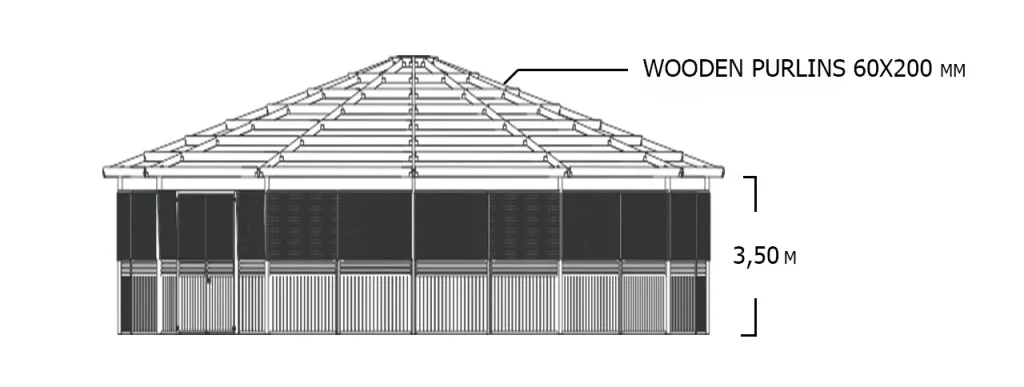The covered lunge pen from the Ground Up – Thoughtful Design for Safety and Durability
The right covered lunge pen is a key component for professional and safe horse training – whether in recreational sports, therapy, or competitive sport.

What dimensions are suitable for a covered training area?
The size should always be adapted to the intended use and the number of horses. Halls that are too small restrict freedom of movement and can lead to uneven strain.
Recommended dimensions:
Round training areas:
• A diameter of 16 to 18 meters is perfectly sufficient for regular lunging.
• A 20-meter diameter offers significantly more space, especially when using additional training equipment or working with multiple horses.
Oval or rectangular training areas:
• These are often used for more versatile training, such as lunging, free jumping, or groundwork.
• Common dimensions: 15 × 30 meters or more – depending on the specific concept.
Straight or slanted kickboards – which shape makes sense and which is better suited?
The choice between straight and slanted kickboards plays an important role in safety and training comfort.
• Straight kickboards are vertical, space-saving, and cost-effective. They are easy to build, but in close contact, a horse can bump into them more easily.
• Slanted kickboards are angled inward and more horse-friendly. They offer greater safety, as the horse is more likely to slide along them rather than come to an abrupt stop. They also feel less confining – a clear advantage, especially for young or sensitive horses.

The choice of shape strongly depends on the training goals:
• Round riding arenas are the classic option. They provide even strain on the horse’s joints and are ideal for lunging, liberty work, or horse walkers.
• Oval or rectangular arenas offer more freedom of movement and are suitable for versatile use, but they require more space and are often more complex to construct.
What height is recommended for the training area for horses?

Height should not be underestimated – it affects both the indoor climate and the sense of safety:
• Side height: at least 3.5 to 4 meters
• Ridge height: ideally 5 to 6 meters for optimal air circulation and a spacious feeling
Stable & Secure: How the Supporting Structure of a Lunging Arena is Built?
The supporting structure forms the static framework and carries the roof as well as the side walls, if present. It is usually made of wood or steel, depending on the desired appearance, budget, and technical requirements.
• Wood (glulam) is especially popular due to its natural look, good load-bearing capacity, and sustainability. The construction is often circular with a central support post and radially arranged roof beams.
• Steel structures are robust, durable, and ideal for larger spans. They allow an open design without a central support and are often used in modular construction with a tarp roof.
• Hybrid solutions (e.g., wooden beams on steel posts) combine stability with aesthetics.
The choice of material influences not only the structural integrity but also the character of the arena—whether rustic, modern, or functional.

Filling Materials for Lunging Arenas: Wood, Plastic, or Metal?
• Wood Fillings:
Robust types of wood such as pine, Douglas fir, larch, denya, bongossi, or bamboo are used. They create a natural atmosphere and provide good shock absorption. Important: a weather-resistant surface treatment is essential.
• Plastic Panels:
A modern alternative to wood. Particularly low-maintenance, UV-resistant, and available in various colors. Plastic fillings are ideal for arenas that should require minimal upkeep
• Metal Panels (e.g., trapezoidal sheets):
A robust and durable solution that ensures long-term structural integrity. Thanks to their weather resistance, these elements are ideal for year-round use.

Wind Protection Net – Small Measure, Big Effect.
A wind protection net is a sensible addition. It reliably protects against wind, rain, dust, and sun without fully enclosing the arena. This makes training less dependent on the weather, safer, and more comfortable – for both horse and rider. At the same time, air circulation is maintained, which positively influences the stable climate. Important factors are the correct mesh size, UV resistance, and a stable mounting system. Anyone who wants to create optimal conditions year-round makes a thoughtful choice with a wind protection net.
How can optimal lighting be achieved both during daylight and in the evening to ensure ideal training conditions?

A well-designed lighting system is crucial for safe training – ideally, it combines natural daylight through a roof lantern with glare-free, energy-efficient LED lighting for gloomy days or evening hours.
